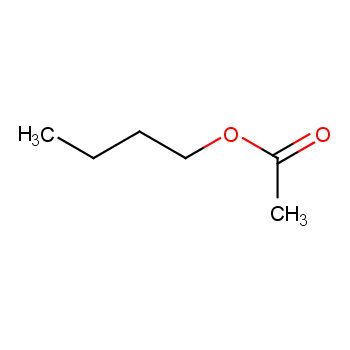



|

| 品牌 | 德诺 |
| EINECS编号 | 204-658-1 |
| 英文名称 | Butyl acetate |
| CAS编号 | 123-86-4 |
| 纯度 | 99.9% |
| 别名 | 醋酸正丁酯 |
| 分子式 | C6H12O2 |
| 产地/厂商 | 国产 |
butyl acetate
密度:0.88
熔点:-77.9℃
沸点:-108.2° F (NTP, 1992)
折射率:1.393-1.395
闪光点:72° F (NTP, 1992)
蒸汽压:11.5mmHg at 25°C
PSA:26.30000
logP:1.34960
溶解度:5.3g/l
Λ:λ: 254 nm Amax: 1.0λ: 260 nm Amax: 0.20λ: 275 nm Amax: 0.04λ: 300 nm Amax: 0.02λ: 320-400 nm Amax: 0.01
黏性:Viscosity is a measure of a fluid's resistance to flow. It describes the internal friction of a moving fluid.
蒸汽密度:4 (vs air)
分析实验室方法:Method: NIOSH 1450, Issue 3; Procedure: gas chromatography with flame ionization; Analyte: n-butyl acetate;; Matrix: air; Detection Limit: 0.9 ug/sample.
外观:无色液体带有一种水果的气味
大气OH速率常数:4.90e-12 cm3/molecule*sec
自燃:760° F (USCG, 1999)
存储:储存注意事项储存于阴凉、通风的库房。远离火种、热源。库温不宜超过37℃。保持容器密封。应与氧化剂、酸类、碱类分开存放,切忌混储。采用防爆型照明、通风设施。禁止使用易产生火花的机械设备和工具。储区应备有泄漏应急处理设备和合适的收容材料。
自燃温度:790 °F
致癌性:There are no indications of mutagenic orcytogenic effects for n-butyl acetate.
化学性质:Butyl acetate is a colorless or yellowish liquid with a strong fruity odor. burning and then sweet taste reminiscent of pineapple. It occurs in many fruits and is a constituent of apple aromas. Butyl acetate is incompatible with strong oxidizing agents, strong acids, and strong bases.There are 4 isomers. At 20 °C, the density of the n-butyl isomer is 0.8825 g/ cm3, and the density of the sec-isomer is 0.8758 g/cm3 (Bisesi, 1994). The n-butyl isomer is soluble in most hydrocarbons and acetone, and it is miscible with ethanol, ethyl ether, and chloroform (Haynes, 2010). It dissolves many plastics and resins (NIOSH, 1981).
物理属性:Clear, colorless liquid with a strong fruity odor resembling bananas. Sweetish taste as lowconcentrations (<30 μg/L). Experimentally determined detection and recognition odor thresholdconcentrations were 30 μg/m3 (6.3 ppbv) and 18 μg/m3 (38 ppbv), respectively (Hellman andSmall, 1974). Cometto-Mu?iz et al. (2000) reported nasal pungency threshold concentrationsranged from approximately 550 to 3,500 ppm.
颜色:无色透明液体,有水果香味。[1]
分解:When heated to decomp it emits acrid smoke and irritating fumes.
燃烧热:-13.130 BTU/LB = -7294 CAL/G = -305.4X10+5 J/KG
汽化热:36.28 kJ/mol at BP; 43.86 kJ/mol at 25 deg C
亨利法律常量:2.81e-04 atm-m3/mole
电离电位:10.00 eV
气味:Strong fruity odor
气味阈值:0.016ppm
pH值:6.2 (5.3g/l, H2O, 20℃)(External MSDS)
物理属性:具有愉快水果香味的无色易燃液体。 与醇、酮、醚等有机溶剂混溶,与低级同系物相比,较难溶于水。
溶解性:微溶于水,溶于乙醇、乙醚、烃类等多数有机溶剂。[15]
光谱特性:INDEX OF REFRACTION: 1.3941 @ 20 DEG C/D
SADTLER REFERENCE NUMBER: 10971 (IR, GRATING)
IR: 1041 (Sadtler Research Laboratories Prism Collection)
NMR: 140 (Varian Associates NMR Spectra Catalogue)
稳定性:
1.化学性质:与低级同系物相比,乙酸丁酯 难溶于水,也较难水解。但在酸或碱的作用下,水解生成乙酸和丁醇。乙酸丁酯在石英管中加热至500℃时,分解为乙酸和丁烯。与氮一起通过500℃的玻璃棉时,主要生成1-丁烯,少量的副产物有丙烯、2-丁烯、乙烯等。以氧化铝为催化剂加热至300~330℃,生成氯丁烷、氯代异丁烷、乙酸异丁酯,以及少量的甲烷、乙烷、丙烷、丁烯等。与苯一起在氯化铝存在下加热生成丁基苯及少量4-丁基苯乙酮。将乙酸丁酯用丁醇钠处理生成乙酰乙酸丁酯。与异丙醇铝一起加热生成乙酸异丙酯和丁基铝。乙酸丁酯也能发生醇解、氨解、酯交换等酯类共有的反应。发生光氯化反应时,得到7.0% 1-氯取代物和30% 4-氯取代物。乙酸丁酯与三氯化铝形成加成化合物,该化合物在0℃时为液体,132℃以上分解。
2.稳定性 稳定
3.禁配物 强氧化剂、碱类、酸类
4.聚合危害 不聚合
存储温度:Flammables area
表面拉伸:14.5 DYNES/CM = 0.0145 NEWTONS/MET AT 25 DEG C
用途用于火棉胶、硝化纤维、清漆、人造革、医药、塑料及香料工业中.是一种优良的有机溶剂,能够溶解松香、聚醋酸乙烯、聚丙烯酸酯、聚氯乙烯、氯化橡胶、杜仲胶、聚甲基丙烯酸甲酯等。;
用作分析试剂、色谱分析标准物质及溶剂;
是优良的有机溶剂,广泛用于硝化纤维清漆中,在人造革、织物及塑料加工过程中用作溶剂,也用于香料工业;
GB 2760一96规定为允许使用的食用香料。作为香料,大量用于配制香蕉、梨、菠萝、杏、桃及草莓、浆果等型香精。亦可用作天然胶和合成树脂等的溶剂。;
偶用于果香型香精中,主要取其扩散力好的性能,更适宜作头香香料使用,但用量宜少,以免单独突出而影响效果。可大量用于如杏子、香蕉、桃子、生梨、凤梨、悬钩子、草莓等食用香精中。;
优良的有机溶剂,对醋酸丁酸纤维素、乙基纤维素、氯化橡胶、聚苯乙烯、甲基丙烯酸树脂以及许多天然树脂如栲胶、马尼拉胶、达玛树脂等均有良好的溶解性能。广泛应用于硝化纤维清漆中,在人造革、织物及塑料加工过程中用作溶剂,在各种石油加工和制药过程中用作萃取剂,也用于香料复配及杏、香蕉、梨、菠萝等各种香味剂的成分。;
常用有机溶剂, 检定铊、锡和钨, 测定钼和铼, 抗生素萃取剂。